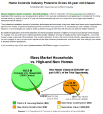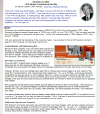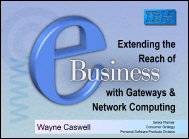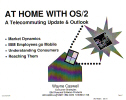Portfolio of Articles, Flyers & White Papers
This portfolio includes various writing samples and features my graphic arts and page layout talents, even using relatively simple tools like Microsoft Word, PowerPoint & Paint and utilities like HyperSnap & Pixie Color Grabber.
 |
Modern Health Talk (2011 tri-fold brochure) This is the first brochure for Modern Health Talk, an online community connecting people with low- and high-tech solutions for home healthcare and aging-in-place. |
|
The Homeowner's Bill of Rights (2009 tri-fold brochure) I created this handout for the Democratic National Convention. Homeowners of Texas, a nonprofit consumer advocacy, was urging Congress to adopt a Homeowners' Bill of Rights that includes financial, legal, and disclosure reforms. |
|
|
Texas Homebuilding and the Global Financial Collapse (2009 white paper) In this paper, I put Texas homebuilders and the repeal of the Glass-Steagall Act at the center of the housing bubble and resulting economic tsunami. That's because politically connected builders were able to reverse the regulatory oversight and accountability that was imposed in the 1930's, allowing them to own mortgage, title and insurance companies and resell risky loans to foreign investors as mortgage-backed derivatives, essentially teaching banks how to do the same.. |
|
 |
Soil Issues for Residential Construction in Texas (2009 white paper) Two concerns arise from homes built on reclaimed farm and ranchland. The first relates to expansive soils that are unsuitable for building and that cause foundation problems and threaten the structural integrity of homes. (HOT was able to get a new law passed requiring engineered foundations.) The second concern is residual contamination from toxic pesticides or industrial waste that can cause serious health problems. These two issues are especially troublesome because of the rapid rate of urban sprawl in our state. |
 |
Homebuilder LICENSING (2009 Legislative Flyer) (2009) This flyer was very effective in contrasting Licensing versus Regulation, as well as Texas consumer protections when buying New homes versus Existing homes. |
 |
Mandatory Binding Arbitration: Unfair & Everywhere
(2009 flyer) |
 |
HOT Honor's America's Best Builder (2009 flyer)We wanted to honor good builders, but with so many unscrupulous ones in Texas, we featured Ms. Helen Dragas in this flyer as an example of what we were looking for. |
 |
Introducing TAL Security, Social Networking and Collaboration (w.paper) Explains the risks and benefits of Internet and Cloud computing services offered to the Texas Association of Landmen. |
 |
XPS™ One™ Sales Aid (2007 2-page flyer) I created this for Dell as Messaging Manager for consumer desktop PCs. I did the layout and graphics and wrote all of the copy. Before leaving Dell, I got permission to use documents shown here as samples of my work. |
 |
XPS™ One™ Reviewer's Guide (BIG File - 14MB PDF, 2007) I wrote Messaging Guides for Dell sales and online teams and Reviewer's Guides for the press. We'd include these high-quality guides with evaluation systems sent to product reviewers, and this one was widely praised as "Dell's Best Ever." It helped earn numerous Editor's Choice awards, such as this one from PC Magazine. |
|
|
This technical 2007 paper describes Dell's hybrid H2Ceramic (H2C) cooling system, which is used in high-end Dell XPS gaming systems. This Wikipedia article was written to make it easier for people to find information about H2C and the Peltier effect, and to link to the technical paper and a 17-minute video from one of the inventors. |
 |
Media Center Extenders (4-page brochure) As Dell Messaging Manager for consumer desktop PCs, I created this brochure with help from Linksys for Dell's CES product launch. The images and messaging were a collaborative effort between the two companies. |
 |
Dell Blueray Disk Bonus Pack (cover art) I crafted a super-high resolution graphic using Microsoft PowerPoint, to be used as cover art for Dell's Blueray Disk Bonus Pack, which shipped with any PC with that feature. The PDF version here is much lower resolution to save disk space and network transmit time. |
 |
Apple Design Language (internal Dell presentation) I often took the initiative to suggest improvements to Dell's products, including features, design, messaging, and branding. Here I made an example of Apple, which has a consistent design language across products that reinforces its brand. |
 |
Home Technology Integration: A Technology Forecast (2006 market research) Under a consulting contract with Technology Futures, Inc. I helped write this report for the Texas State Leadership Consortium for Curriculum Development. It examines HTI trends and concludes that community and technical colleges are ideally suited to offer home technology integration training and that curriculum should be structured around local industry advisory committee recommendations and the industry approved CompTIA HTI+ certification. Students should be expected to complete this important certification upon graduation. |
 |
Telecom Choice, Voice & Consumer Protection (2006 advocacy paper) The Texas Public Utilities Commission, which was studying issues of network neutrality and choice. This paper gave a consumer perspective, identified eight consumer protections missing from state & federal legislation, and argued that policy makers need to more actively seek outside input from individuals, small businesses, and organizations not represented by highly paid lawyers and lobbyists. |
 |
BIG BROADBAND: Public Infrastructure or Private Monopolies (2004 white paper & presentation)This paper contrasts the different incentives of incumbent ISPs, municipalities and other stakeholders, suggesting that the cost of extending fiber closer to premises is high enough to cause IPSs to cherry pick the most profitable customers, leaving others to fend for themselves. That’s where public broadband comes in, but the politics can pose obstacles for municipalities that want their own networks, so this paper also includes a section explaining the fears of various stakeholders. Incumbent phone companies, for example, fear competition from VoIP alternatives and are using their deep pockets and powerful lobbyists to delay competition as long as they can. |
 |
Home Controls (2004 market research)The home controls industry is poised to cross a 30-year-old chasm separating high-end new homes from much bigger opportunities in mainstream retrofit markets. Caswell was contributing editor with Tricia Parks of Parks Associates.
|
 |
Twenty-Twenty Vision: 20 Years of Technology (2004 article, also available as formatted PDF - 52KB).This article was written for CABA QUARTERLY to give builders insight into future technologies that affect home networks, but it is also useful for homeowners, product manufacturers and broadband service providers. Twenty-twenty Vision starts by looking back twenty years and then looking forward. It expands on three previous articles written for HomeToys.com on Technology Trends, Market & Consumer Trends and Social & Economic Trends. |
 |
Internet Telephony: Coming to a cable outlet near you (2004 article)Because VoIP service is digital and enables convergence, it enables new apps and benefits but also introduces new regulatory issues.
|
 |
Sound Solutions for Wireless Woes (2004 report, also as formatted PDF)The emerging wireless technologies discussed in this report will have a compounding effect that greatly extends the reach of wireless networks and improves performance by as much as 10,000 times the speed of dial-up 56 Kbps modems.
|
 |
Wireless LAN Buyers Guide (2003 article, also as formatted PDF).I went to Fry’s to buy more wireless LAN equipment for my home office and was amazed at nearly 100 SKUs to choose from, representing each version of the Wi-Fi standard, and wondered how consumers might ever make sense of it all. While I pondered my purchase, I overheard two college kids ask a sales associate to for help. The sales rep offered some advice, but it was clear that his knowledge was limited. I introduced myself as a wireless consultant and answered some basic questions. Our casual discussion evolved into a 20-minute WLAN course that attracted a dozen onlookers who also bought wireless products. The father of one young man thanked me for condensing so much information into such a timeframe, and that fun experience convinced me to write this article and explain the tradeoffs that can help you make your own WLAN decisions. It contains a useful comparison grid. |
 |
Reviving the FORGOTTEN Information Superhighway (2003 article, also as formatted PDF)Debate still lingers over government’s role in building an Information Superhighway and whether our lack of a national broadband policy means the concept is forgotten. Broadband – the “always on” network connection that receives and transmits digital content and services at high speeds – was supposed to change the way we live, work and play … as well as how we learn, shop, make things, entertain ourselves, and interact with others. It was supposed to give us remote access to libraries, museums, medical care, jobs, and government – resources that are available only to people living nearby. But since that aging vision is coming slower than expected, this paper aims to revive the initiative. |
 |
Wireless in 2003: CES Shows Consumers the Way (2003 article)I attended CES to follow the wireless industry and wrote this event report as an extension of a speech I gave to the International Wireless Packaging Consortium the week after the show. CES attendance broke all previous records in the face the 2002 economic recession, and the show attracted more than 2,200 exhibitors and over 100,000 attendees. It was clear that all sorts of wireless markets remain hot -- from Wi-Fi and Bluetooth, to mobile phones, satellite radio, GPS navigation, and more. All of this activity benefits consumers by driving down prices, improving performance, and adding function. Wireless PC adapters now sell for less than $50, and wireless routers sell for less than $100. Even with confusion among the competing standards, it was a good time to buy. |
 |
HomeRF ArchivesBe sure to also check out this HomeRF Flyer and the HomeRF Archives, a rare collection of white papers, presentations, flyers, and FAQ. Even though the HomeRF Working Group disbanded at the end of 2002, the open spec is still available, and this page tells all about it and includes many of the white papers and presentation slides I created when I was the Marketing Chairman. |
 |
Bandwidth: How much is Needed, and How much is it Worth (2002 article)Applications determine bandwidth needs and costs. Health monitoring, for example, requires very little bandwidth but saves lives and has high value. If your applications only need to send text and data, then dial-up modems can provide enough bandwidth for your needs, and they cost less than broadband. The Internet experience is enriched by added graphics, images, sounds and video, but this requires more bandwidth. |
 |
Wireless Wars or Wireless Weddings (2002 article)Innovative semiconductor companies are introducing software-defined radios for wireless LANs this year, and we already see examples of multi-mode in mobile phones and enterprise wireless access points. I expect to see multi-mode PC adapters in 2002 that help move the industry away from the confusing Wireless Wars to a more cordial Wireless Wedding. Consumers and industry will both benefit from this new direction.
|
 |
Inexpensive Toys for Big Boys: The Role and Challenges of Wireless Entertainment (2001 article)Some of the products discussed provide adequate performance under ideal conditions, but there are many things that emit radio interference that can impact performance. These include stadium lights, cordless phones, microwave ovens, wireless LANs, and anything else that operates in the unlicensed 900 MHz or 2.4 GHz frequency band. For surveillance and most music applications, the impact is often acceptable, but for more demanding audio and home theater applications, you would be better off buying more advanced technology based on the proprietary technology from Cirrus Logic or the open HomeRF specification. |
 |
Q&A with HomeRF (2001 Network World interview)This interview with Wayne Caswell, HomeRF marketing manager with Siemens ICM, offers information about industry support for HomeRF.
|
 |
Wireless Tower of Babel (2001 article)If there’s a Wireless Home Networking lesson to learn from the Tower of Babel, it’s that we don’t need (and may never have) one wireless standard for homes, offices, schools, airports, restaurants, grocery stores, bowling alleys, and beauty shops. As intriguing as it may sound, it is not practical or desirable to have one wireless standard for all environments, purposes, and types of devices.
|
 |
Telephony Unplugged: Next Generation Home Phone Systems (2001 article)Because HomeRF supports up to eight toll-quality voice lines simultaneously, broadband carriers can allow each family member to have his or her own number and remotely provision new phone numbers and services. Rather than being limited to just two phone lines, broadband customers with HomeRF will be able to activate additional lines as younger kids grow up, when older kids come home from college, or when visiting guests arrive, even transferring their own number. |
 |
Which standard is better for teleworkers: Wi-Fi or HomeRF? (2001 Network World Face-off)Specifically designed for homes, HomeRF is (was) the best choice for teleworkers because working from home or on the road introduces network requirements that enterprise wireless LANs still can't address. IEEE 802.11 variants, such as Wireless Fidelity (Wi-Fi), fail to provide toll-quality voice services and compare poorly in such aspects as power consumption, reliability and support for high-network-density environments such as apartment buildings. |
 |
Social & Economic Trends Affecting Home Networking (2001 article)In this last of a three-part series, I will explore some of the Social and Demographic trends that are driving the development of the Networked Home. The first article covered Science and Technology Trends, and the second focused on Market and Consumer Trends. As always, your comments and suggestions are encouraged. |
 |
Market & Consumer Trends Affecting Home Networking (2000 article)This is the second of three articles that examine key trends enabling and driving the development of the Networked Home. The first article covered Science and Technology Trends while this one discusses Market and Consumer Trends. The final installment will address Social and Demographic Trends. As always, your comments and suggestions are encouraged. |
 |
Twenty Technology Trends that Affect Home Networking (2000 article)What is driving and enabling the Networked Home? This question is common among homebuyers who don’t want their new home to become obsolete before they sell and move out (or even before they move in). Builders also ask it, since they don’t want to add new features until customers demand them. And companies that make the products, services, and technologies want to understand the market opportunities, leverage points, alliances and risks. Although the question is simple enough to ask, the answer can be complex, since it is surrounded by a collection of market, economy and technology trends. |
 |
Powerline Home Networks: Plug Into The Internet (2000 article)With powerline networking, you’ll be able to put your desktop PCs anywhere you like instead of being forced to put them by a phone outlet. It will also be easier to buy and network other devices – printers, scanners, DSL and cable modems, TV set-top boxes, game consoles, screen phones and major appliances. |
 |
Information Appliances and Pervasive Net Access (2000 market research)The vision is for Internet access by anyone, anytime, anywhere, and on any device - truly pervasive Net access - and the report covers a wide variety of information appliances and their means of connecting. After providing an overview with descriptions of the market segments, overall benefits, and macro-level drivers and opportunities; this report provides detailed descriptions of each segment, along with the specific drivers, opportunities, and major players. Three chapters then focus specifically on the enabling hardware, software, and networking technologies that serve these markets. The last chapter of this 340-page report offers detailed forecasts. |
 |
Wireless Home Networking: Disconnected Connectivity (2000 article)The cost of connecting PCs with radio waves instead of wires is now as low as $99 per system, and there are several technologies to choose from. But that's the problem - too many to choose from. Since a confused market doesn't buy, I'm dedicating this second HomeToys.com "mentor" article to positioning the three emerging wireless standards - Bluetooth, IEEE 802.11b, and HomeRF. |
 |
Future Proofing Your Home: Is it Possible? (2000 article)New types of devices have helped to change the thinking of home networking experts. Six years ago they said to put bedroom phone outlets by the bed and TV outlets across the room. But they didn't anticipate interactive program guides or NetTV devices that require both a phone and TV outlet. So today they put a phone outlet by every TV outlet. Still, no one can fully anticipate future wiring needs, and that's the message of this article. |
 |
HomeRF lets you UnPlug-and-Play (1999 article)The Home Radio Frequency Working Group has a vision - to enable the communication and sharing of voice and data from anywhere in and around the home without wires and using a variety of interoperable devices -- PCs, peripherals, cordless telephones, and other consumer electronic devices. |
 |
HomeRF: Getting Wired about Wireless (1999 article)(August 1999). This special feature focuses on the HomeRF Group and the Shared Wireless access Protocol, which is partly based upon DECT technology. This feature has been kindly contributed by Wayne Caswell of IBM Microelectronics. |
 |
Interview with the HomeRF Working Group (1999 interview with HomeToys.com)HomeRF is working to provide the foundation on which a broad range of consumer electronic devices can interact through digital wireless technology. The Shared Wireless Access Protocol (SWAP) provides member companies with that foundation. The products that member companies will eventually provide will offer consumers a user experience unlike any other. Consumers no longer have to be "tied down" to a modem connection or an electrical or phone outlet. They will be free to move about and still use their PC effectively. |
 |
LIGHTning Strikes Cause Bandwidth Glut (1999 article for IBM Microelectronics)(December 1998). The paper predicted trouble for the telecommunications industry because of a pending glut in available bandwidth. This glut will be caused the deployment of more optical fibers, plus the use of WDM to support more colors per fiber, plus semiconductor advances that enable lasers that pulse faster. |
 |
Digital Convergence in the Home (article for Microelectronics Design, Feb.1998)The difference between TVs, computers, phones and other digital devices is becoming irrelevant. In the past, separate forms of information content (text, sounds, pictures, and video) were sent over special-purpose networks and accessed by dedicated devices. Once digitized into bits, however, this content can be combined and sent across diverse networks, and manipulated by a variety of devices. Convergence gives consumers more value and a choice of network and access devices. It also affects the way they use technology and even fuels economic and social change. But, in the process, convergence commoditizes consumer products and increases competition. And this puts additional pressure on manufacturers, who need to keep adding new technologies while also becoming more agile and efficient. The development of networked, digital devices with competitive price, function, and flexibility is a challenging task. (Hard copy is available upon request.) |
|
|
The Residential Gateway (published in International Engineering Consortium’s 1996 Annual Review of Communications, p.457)Caswell was coauthor of this first RG concept paper, along with Bellcore, B&C Consulting, David Sarnoff Research Center, Hewlett-Packard, IBM Research, GTE, and Reliance Comm/Tec. This is the first known white paper describing the RG concept, and it sparked several standards initiatives. These include the Open Service Gateway Initiative (OSGi), ANSI/TIA/EIA TR41.5 Residential Gateway Task Group, and IEC/ISO JTC1 SC25 Working Group 1 - Home Electronic System (HES). |
 |
IBM's Inter|section Gateway Initiative (1997)"Extending the Reach of eBusiness with Gateways and Network Computing" was presented to IBM management to justify investing in the Residential Gateway market. This slide set and accompanying notes describe early concepts and design decisions, as well as the challenge of promoting consumer products in a company that had bad experiences in consumer markets. To get attention, I used the term, Inter|section Gateway instead of Residential Gateway and spoke of the impact on IBM's enterprise business. |
 |
OS/2 Warp for Playing & Developing PC Games (1999 white paper)This document focuses on specific OS/2 Warp features that apply to PC gaming. It assumes that the reader is already familiar with OS/2 as a PC operating system. The first section, "OS/2 Warp for PC Gamers," describes OS/2 as a games platform, solving many of the problems PC users face when playing games under DOS or Windows, and helping to usher in a new breed of high-performance 32-bit games. It was published in IBM Personal Software Technical Newsletter, Issue 1, 1995. The second section, "OS/2 Warp for PC Game Developers," describes unique advantages OS/2 has as a development platform and contains detailed information for program developers. It was published in the May/June 1995 issue of IBM Personal Systems Technical Solutions magazine. (Hard copy is available upon request.) |
 |
At Home with OS/2: a Telecommuting Update and Outlook (1994 white paper)This paper discusses IBM's OS/2 as the preferred platform for telecommuters (with its strong client/server benefits) and for home computing (with the new Personal OS/2, designed specifically for home and mobile users). The first section gives a high-level view of telecommuting growth and benefits, along with examples from IBM's internal TC experiences and with recommendations for establishing similar programs. Next, is a discussion of the home computing markets and OS/2's current benefits there, its challenges, and IBM's plans for it. (Hard copy is available upon request.) |
 |
Home Computing with OS/2 (1993 article for IBM Personal Software Technical Newsletter)This paper shows PC users how IBM technologies can be applied to home computing applications and how OS/2 provides unique benefits as a PC operating system for the home. There is still much work to be done to make OS/2 (and personal computers in general) more of a consumer product, like the telephone or TV or VCR. Almost every household in America has a phone and TV. Many have several. Computer technology, however, is still too new, lacks compelling applications, and is too difficult to use for many consumers to be interested. That's the current view, but OS/2 is helping to change that view. (Hard copy is available upon request.) |

